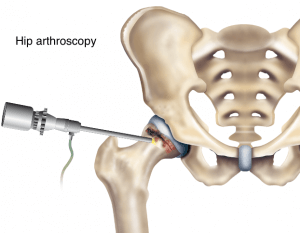Hip Arthroscopy
This is keyhole surgery on the hip joint. It can be used to assess the state of the hip joint tissues, or used to treat certain conditions. Commonly treated conditions include;
- Labral tears
- Loose bodies
- Cartilage defects
- Impingement problems (bumps on the thigh bone)
The operation is performed under a general anaesthetic. The anaesthetist will discuss other additional methods of pain relief with you, such as injections around the spine (epidural injections, lumbar blocks).
Under anaesthetic, the hip is stretched out by placing the leg on traction. Two or more small cuts are made around the hip, and fine instruments are inserted into the hip joint. As the hip is deep inside the body, access can be limited. Once inside the hip joint, it is possible to undertake treatment of certain conditions.
Post operative Treatment
After a hip arthroscopy, you will normally spend one night in hospital. You will be given crutches to help with walking. You will be encouraged to exercise the hip immediately under the guidance of a physiotherapist. I recommend and exercise bike or cross trainer type machine to most patients as this is a good method of exercising the hip. It can take a few months to fully recover from the surgery, depending on the procedure performed. The wounds can leak fluid for a few days after surgery
Complications and Risks
- There will be scars around the hip. These are normally 1-2cm long.
- There is a risk of a temporary numbness around the hip and groin due to the traction
- There is a very small risk of a serious infection
- There is a very small risk of a permanent injury to nerves and blood vessels in the leg
- There is a small risk of skin breakdown in the groin due to traction pressure
- There is a small risk that the hip cannot be entered, or that access will be too tight to allow work to be done in the joint
- There is a small risk ( 1 in 20) that pain will be worse after the procedure, either due to complications, progressive wear and tear in the joint or unknown reasons
